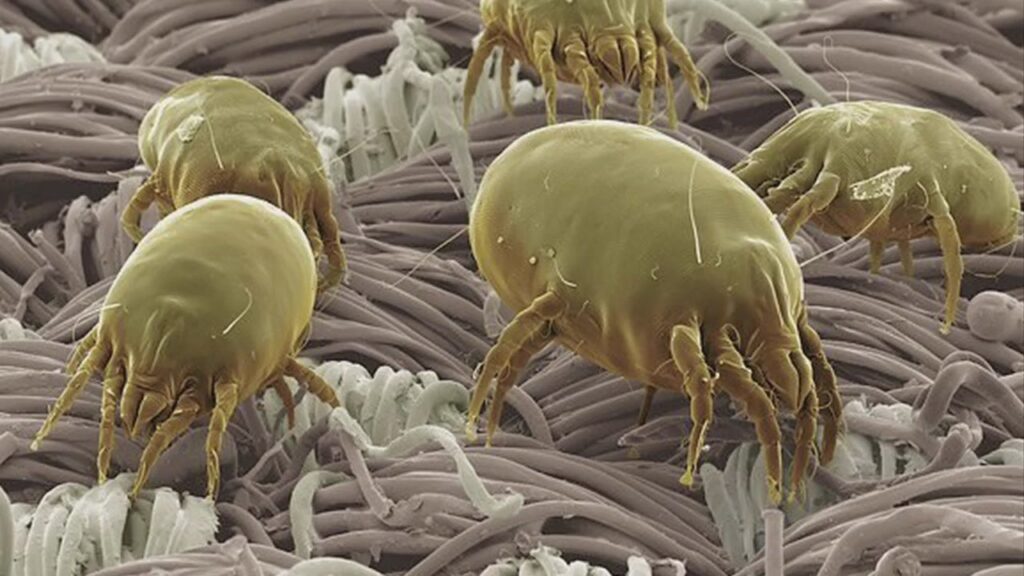Dust mites, their body parts, and their feces are the most common household allergens.
According to the scientists signs of dust mite allergy include those common to hay fever, such as sneezing and runny nose. Many people with dust mite allergy also experience signs of asthma, such as wheezing, difficulty breathing and even a skin rash.
If you are reading this, chances are you or someone you love was recently diagnosed with an allergy to dust mites. People that are recently diagnosed may experience a wide variety of feelings.
Some are in denial, (How can a bug make you sick? But I keep a clean house!) some are overwhelmed (This just seems like too much effort or I will never keep it up!), but the vast majority are mad at the dust mites and are ready to declare war.
Highly Effective Ways to Get Rid of Dust Mites
- First, You Have to Know What a Dust Mite Is.
- Get Rid of Their Home or Make it Uncomfortable.
- Starve the Enemy.
- Hot Water Washing and Cleaning.
- Frequent Vacuuming and Dusting.
- Professional Upholstery Cleaning
So here is the basic information about dust mites:
- Dust mites, their body parts, and their feces are the most common household allergens.
- These allergens are the source of sneezing, coughing, itchy and watery eyes, stuffy noses, eczema, and asthma.
- Dust mites are microscopic creatures that feed on shed human skin cells.
- Dust mites do not bite you.
- You cannot see dust mites, and you cannot feel them.
- Dust mites prefer areas where it is dark, moist, and there is plenty to eat.
- Fiber surfaces are their favorites.
- The bedroom is the most widely infested room in the house.
- Your mattress, pillow, and blanket are the perfect environment to meet all their needs.
- Our sleeping environment is full of fibers that trap shed dust mite carapaces and feces, making it a literally a hotbed of allergy activity (pun intended).
Clearly, dust mites are not welcome in the home. Here are 5+ highly effective ways to get rid of dust mites and their allergens as well as a few that we don’t really recommend, but they will work.
Dust mites look for places that are dark, warm, and filled with their favorite food, shed human skin cells. Therefore, they love fiber surfaces. Fibers give dust mites a hiding place and fibers collect food and trap moisture.
Fiber surfaces are not easily cleaned. So, over time, more and more dust mite allergens collect in fibers.
Removing dust mites from fabric surfaces requires a multi-prong approach.
Carpets: While you don’t have loads of dust mites actively living and breeding in your carpets, carpets hold the dead body parts that are a normal part of household dust as well as dust mite feces. Try as you may, you can’t clean the carpet.
Imagine you took your favorite cotton button-down shirt and tossed it on the floor and walked on it for 6 to 9 months. Then to clean it, you splashed a little water and soap on it and then vacuumed it up. Would that shirt be what you called, ahem, “clean”? Nope. But, that’s essentially “carpet cleaning” in a nutshell.
You can spend money on carpet cleaning and carpets will look and smell cleaner, but you can’t really clean carpet deep down where the allergens are. Even when you “steam” clean a carpet, you may kill the mites, but you will not remove the allergens.
Remember, a dead dust mite is just as bad for you as a live one. That is why allergists agree that the best surface for flooring is a hard surface.
That means giving a heave-ho to rugs and carpets. Small throw rugs that can be washed weekly are acceptable. Get rid of all other fiber-based floor coverings. Replace them with tile, hardwood, laminate, engineered wood, vinyl, or concrete floors.
While allergists always say the best thing to ever get rid of when dealing with dust mites is your carpet. Financially speaking that may not be something that can be done right away.
Hard surfaces can be effectively vacuumed and mopped regularly. With hard surface floors, you will actually remove the dust mites, their feces, and their body parts.
Furniture: Just like carpets and rugs, furniture covered in fabric makes a great hiding place that can’t be cleaned thoroughly. Replace your upholstered furniture with hardwood, leather, or synthetic leathers. These hard surfaces don’t collect allergens and they are easily wiped clean.
Window coverings: Remove draperies and replace them with hard surface blinds. If curtains and valances remain, they must be washed or vacuumed and treated with the anti-allergen spray.
Dust catchers: Remove dust catchers and wipe down all hard surfaces at least every 7 days. When cleaning and dusting, everyone always has an aid they use to clean around the home.
While you are at it, get rid of the excess clutter and dust catchers in the bedroom.
.

